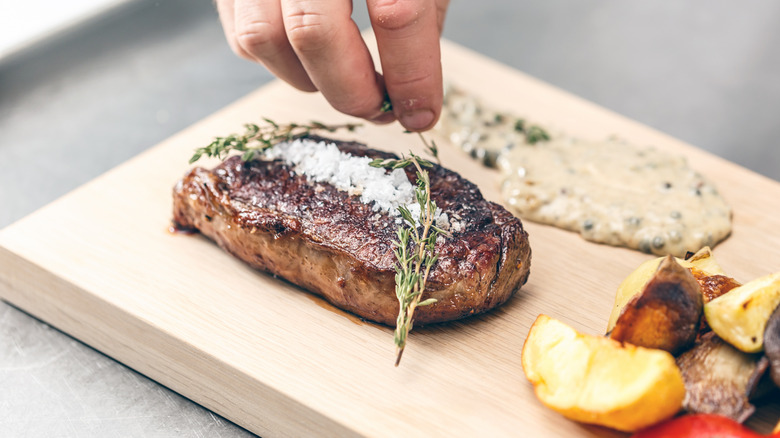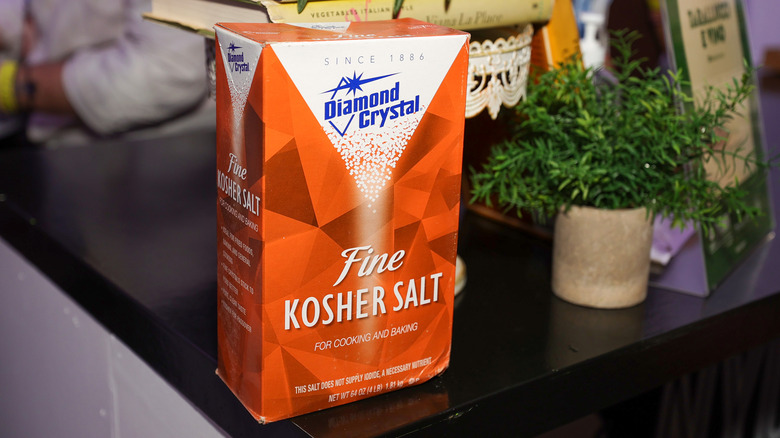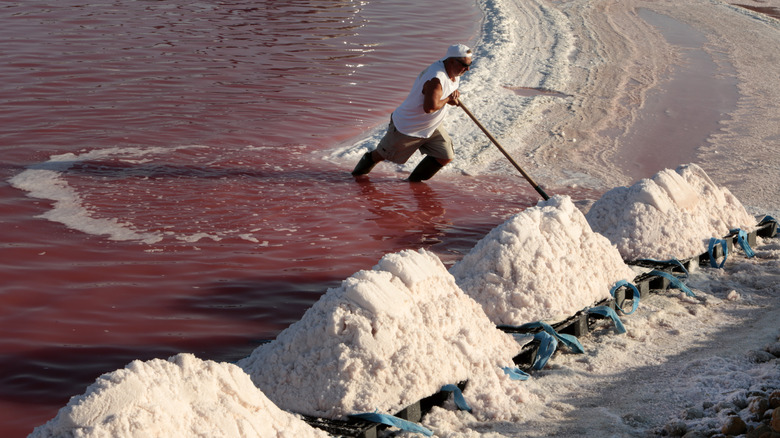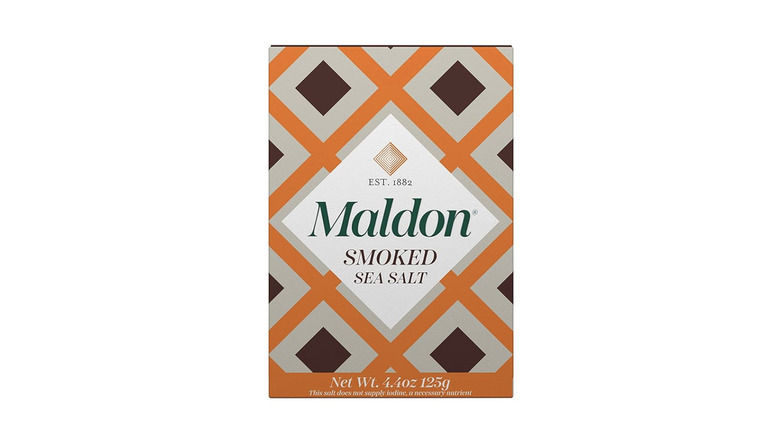Maldon Salt Is The Boujee, Flaked Topping With A Cult Following
We may receive a commission on purchases made from links.
You might have heard about it on the Food Network, or maybe your favorite fancy bakery sprinkles it on top of chocolate chip cookies. Perhaps you've been lucky enough to eat it with slices of juicy sirloin steak. Possibly, you even have a little box of it sitting in your pantry and want to know more about it. No matter how you've encountered Maldon salt, there's no doubt this luxe ingredient comes with plenty of hype. Whether you're trying to figure out how to use it or just want to know why people shell out big money for basic sodium chloride, we're here to explain everything.
Maldon is a special kind of sea salt made by the Maldon Salt Company, based in the town of Maldon, England. It has several unique properties that make it a favorite ingredient of fine dining chefs around the world, and you can take advantage of Maldon in your home kitchen too. In this guide, we'll go over how Maldon is made, what makes it so valuable, and how you can incorporate it into your own cooking.
What is so special about Maldon salt?
The secret behind Maldon's rarefied reputation is its crystal structure. All salt is composed of the same chemical: sodium chloride. The differences between varieties of salt mostly come down to the shape and size of the individual salt grains. Sodium chloride naturally wants to crystalize in cubes, but the crystalization process can be manipulated in order to produce other shapes. Maldon is special because each grain is a large, hollow pyramid. Other fancy sea salts are also pyramid-shaped, but Maldon's pyramids are particularly large. This makes it desirable for a couple of reasons. Perhaps most importantly, the shape gives Maldon a pleasant crispy texture that enhances the mouthfeel of any food. Another advantage of the big pyramids is that, because of their large surface area, they melt over a wider part of your tongue than regular salt, making their flavor seem less harsh.
While the magic behind Maldon salt's giant crystals is a bit of a mystery, we know that there are certain ways to encourage the formation of pyramid-shaped crystals. Sea salt is produced by concentrating a solution of salt and water until it becomes super-saturated. As the brine becomes stronger, water evaporates, and there isn't enough to hold all the salt, forcing some of the dissolved salt to crystalize. If you start with an extra-concentrated brine, it's more likely that pyramids will form.
What does Maldon salt taste like?
From a chemical perspective, salt is salt — no matter what type, it's all sodium chloride. That means that Maldon tastes like the kosher or table salt you're familiar with for the most part. It's far more prized for its crunchy texture than its flavor.
However, that doesn't mean that Maldon doesn't have a unique flavor, subtle as it may be. People often describe it as fresher, brighter, or cleaner-tasting than normal salt, with a mildness that can read as sweet in the right context.
The reason why Maldon has a distinctive flavor is probably a combination of its shape and its chemical makeup. As mentioned earlier, the pyramid crystals give Maldon a mellower taste, but also, Maldon isn't pure sodium chloride — it retains trace minerals from the natural saltwater it derives from. These tiny quantities of minerals could add nuances to the salt's taste. Other minerals may make themselves known by their absence — the Maldon company claims its salt is less bitter than other brands because it's low in magnesium.
Why is Maldon salt so expensive?
Maldon salt is incredibly pricey relative to the average salt brands you'd find in a supermarket. An 3-pound box can cost nearly $25 on Amazon. Conversely, a 3-pound box of Diamond Crystal kosher salt costs around $12 — less than half the price of the Maldon.
Maldon salt is expensive because the process used to make it is laborious and time-consuming. It all starts with brackish water from the Blackwater Estuary in Maldon, England. This water is harvested and boiled until it's concentrated enough, then the temperature is reduced to allow for crystalization. To encourage the proper pyramid shape, precise temperature control is essential. Once formed, the salt flakes are raked out by hand — each batch takes 24 hours. The salt then needs to be dried before it's ready to package. Maldon is a handmade product in batches, and it carries a price tag that reflects the care that goes into producing it.
How to cook with Maldon salt
The best way to cook with Maldon salt is not to cook it at all. While it's certainly possible to use it in recipes to season food throughout the cooking process, to do so would be wasteful. Once Maldon salt dissolves into broth or melts on the surface of meat you're pre-seasoning for the grill, it might as well be any other type of salt — you're paying the premium for Maldon without seeing any of the crispy benefits of the big flakes. Instead, it's best to use a more budget-friendly salt for most purposes and save the Maldon as a finishing salt, added at the table or just before serving. The crunchy flakes will contribute exciting pops of seasoning and texture to meats, vegetable dishes, and just about any other type of recipe you can think of.
While salt is thought of mostly as a savory ingredient, Maldon is also a great topping for desserts like chocolate chip cookies or fruit pies. The salt will break up the sweetness of desserts, making them taste less one-note.
Maldon salt vs. kosher salt
If you've spent any time reading recipe content, you've likely noticed that kosher salt is popular with the recipe development community. It's a great all-purpose cooking salt for a couple of reasons. For one, it has larger, more irregular grains than table salt, which means it's easier to pinch and sprinkle on food with your hands (table salt tends to just slip between your fingers). However, the grains aren't so large that you can't season food evenly. Additionally, while most kosher salt starts with seawater, just like Maldon, it's refined into pure sodium chloride during the manufacturing process — typically with no trace minerals at all. That means it's always going to taste exactly the same.
In contrast, Maldon's large grains make it less than ideal for non-finishing salt uses, and its mineral content gives it a more distinctive flavor. Both types of salt are worth keeping in your pantry, as they have very different functions — kosher salt is best for general cooking, while Maldon is a perfect garnish.
Maldon salt vs. fleur de sel
Fleur de sel is another type of flaky finishing salt — it's much more similar to Maldon than kosher salt is and can be a Maldon alternative. However, it is distinct from Maldon in a number of ways. For one, fleur de sel comes from France, while Maldon is English. The manufacturing process of the two salts is strikingly different. Maldon is made from brine that's boiled and then held at a precise temperature to grow super-sized salt crystals, while fleur de sel is harvested from seawater that is slowly evaporated in shallow pools using the heat of the sun. The prized pyramid-shaped flakes develop on the surface of the evaporating pools and are raked up by hand before they can sink. Most of the saltwater in the pools crystallizes at the bottom and is used for cheaper coarse salt and table salt.
You can use fleur de sel for just about anything Maldon is good for, but fleur de sel's flakes probably won't be quite as big as Maldon's. Only one company makes Maldon salt, while fleur de sel is available from a number of producers. In the U.S., you'll likely pay more for fleur de sel than Maldon — most brands on Amazon are selling fleur de sel for well over $1 an ounce, while Maldon can be bought for $0.65 an ounce.
Maldon salt vs. Celtic salt
Since Celtic is a word associated with the British Isles and Maldon is a type of British salt, you might assume that Maldon is related to the Celtic sea salt that has been trending on social media lately. Surprisingly, Celtic salt isn't British at all, at least not originally; it's a type of sea salt traditionally harvested in France off the coast of the Celtic Sea, a body of water that borders Ireland, the U.K., and France. In France, Celtic salt is known as sel gris because of its gray color — a byproduct of its mineral content. Sel gris can be found in a flakey finishing salt form or large, rock salt-like granules.
It's easy to find articles online that claim that Celtic sea salt has a myriad of benefits, from supposedly aiding in hydration to detoxifying the body. The hydration claims might have a grain of truth — salt can potentially aid in hydration, particularly if you regularly do some kind of strenuous athletic activity. However, any kind of salt will do — it doesn't have to be expensive Celtic salt. Other purported health benefits are attributed to the salt's trace mineral content, but the amount of minerals in the salt likely isn't enough to have any effect. In reality, Celtic salt is best used the same way as Maldon: as a finishing salt with an interesting flavor.
Salt has been made in Maldon since ancient Roman times
The town of Maldon has been a center of salt production for millennia. Salt was first made there using the natural action of the tides in the salt marshes. Ancient Roman and Saxon saltmakers shaped the land at the edge of the marshes into shallow pans that would catch water at high tide. The pans would naturally concentrate the brine, which would then be turned into salt by boiling in clay pots. Archeological evidence of this process can still be found all over Essex, the region of England where Maldon is located.
The modern Maldon Salt Company, which is the exclusive manufacturer of salt in the town of Maldon these days, was founded in 1882. It has been managed by four generations of the Osborne family, who bought the company in 1922. Until the '70s, the Maldon Salt Company was more of a wholesaler — the salt didn't become legendary for its unique quality until it started focusing more on direct-to-consumer sales. In the past few decades, it has increased greatly in prestige, aided in no small part by its Royal Warrant from Queen Elizabeth, which it received in 2012.
Where to buy Maldon salt
If your grocer carries Maldon, it will likely be in the spice aisle next to the other varieties of salt. You might not be able to find it at a regular grocery store, though chains with a slightly more upscale vibe, like Whole Foods, sometimes stock Maldon products, and certain locations of standard chains like Kroger and Safeway carry it too. There is a store locator on Maldon's site to help you find grocery stores in your area that sell the company's salt.
If you'd rather buy online or don't live near a store that sells Maldon, it's available from many popular online shopping destinations in sizes that range from small 55-gram salt mills up to massive 1.4-kilogram tubs. We're providing links to buy the 8.5-ounce box, which is a good size for most home cooks; all prices were accurate as of the publishing date of this article.
Purchase Maldon salt on Amazon for $5.49.
Purchase Maldon salt at Walmart for $5.49.
Purchase Maldon salt from WebstaurantStore for $5.59.
Varieties of Maldon salt
Maldon salt only comes in two varieties: the original flakes, which we've already discussed at length, and a smoked version. Maldon smoked sea salt has the same flaky texture that makes original Maldon so prized, but it's also smoked over oak wood to add extra flavor. The smoke turns the salt a tawny brown color, making it easy to distinguish from the pure white original.
The smoked salt imparts the flavor of charred oak wood to any food it's sprinkled on, which makes it a natural choice if you're trying to lend a chargrilled taste to food you've cooked indoors (or even to strengthen the smoky taste of food you grilled). The smoke gives the salt a savory, meaty quality that's great for elevating vegetable dishes. It tends to be a bit more expensive than the original Maldon — over $6 for a small 4.4-ounce box on Amazon at the time of writing.
Other than smoked versus unsmoked, your main choices when it comes to Maldon are the package you buy it in. You can grab the size of container that makes sense for your kitchen.
How to store Maldon salt
The Maldon Salt Company recommends storing its product in cool, dry conditions. Specifically, it advises customers to keep salt flakes handy in a salt pig for easy access while cooking. What is a salt pig, you ask? Sadly, it's not a piggy bank filled with salt. Instead, the "pig" in the name is an old Scottish term for a clay pot. Salt pigs are earthenware salt containers with a very specific shape. They're traditionally bent over or designed with a hood over the salt, with an opening on the side rather than the top. This means that the salt is protected from above and doesn't get dirty, but it's also easy to reach into the container to grab some seasoning whenever you need without having to open a lid or use two hands. As an added bonus, the unglazed clay on the interior of some salt pigs absorbs moisture, discouraging the salt inside from clumping.
If a salt pig isn't your style, you can also opt for a salt box or salt cellar with a lid to protect your precious Maldon. Any container that provides easy access while also keeping water and contaminants out will do the trick.
You can make Maldon-style salt at home — sort of
If you don't want to pay the relatively high price to get a box of Maldon salt, it's possible to make flaky finishing salt at home using any type of salt, some water, and a glass or enamel pan. Different people have tried different methods, but they all boil down (no pun intended) to more or less the same idea. First, you dissolve the salt in water, creating a saturated solution. You then keep it heated at a controlled temperature and allow crystals to form on top. Once crystals develop, you skim them off the surface of the brine, and presto: You have flaky salt.
While some people have achieved impressive results with their home salt-making experiments, the process has drawbacks that might make you just want to buy Maldon instead. For one, the concentrated brine is quite caustic; if you try making salt in a metal pan instead of a glass or enamel one, it could damage your cookware. Making flaky salt also takes a lot of time and requires a fair bit of supervision to ensure you catch the crystals at the right time. Even if everything goes right, you're unlikely to produce the perfect pyramids you'll find in a box of Maldon. If you do try it at home, it might be best to think of it as a fun science experiment instead of a long-term solution to save money on fancy salt.












